Here’s my page with Questions and hopefully Answers to some of the most commonly asked questions about spiders. Please submit your questions by emailing me here, and I will endeavour to find out the answer for you.
NO answers are guaranteed. As I will be searching the Internet for the answers as well as using my own personal knowledge (which isn’t all that extensive) please understand that no guarantees can be given as to the authenticity or correctness of the answers. If you are looking to verify any of the various myths that are around about spiders, I suggest you have a read of this great page, it’s very interesting as well!! (It is from USA). Click here.
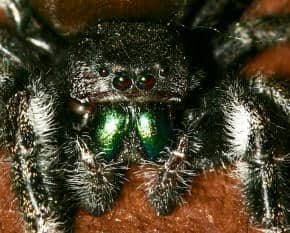
Q. Can spiders hold their breath and if so for how long??
A. Neither spiders nor insects actually breathe; therefore they cannot “hold their breaths.” There is no active pumping of air into and out of those small bodies.
Q. Why do some spiders hang upside down in their webs?
A. Some do and some don’t, but web builders that do so find it more convenient for dangling. Spiders are a huge group, with over 41,000 different species known and they don’t all do the same things. Only about half the species build webs to catch their prey. Of the species that do build webs, many sheet- and funnel-web builders move on top of their webs, head up, rather than hanging. But if you’re going to hang from a web, you need to hang onto the silk, and spiders use tiny claws and associated hairs at the tips of their legs to grasp, and move around on, the silk threads they spin. There are no structures on the tops of their heads or abdomens that would allow them to hang and move.
Q. What is the most intelligent spider?
A. Portia fimbriata, known as the Fringed Jumping Spider or often just as Portia is renowned as the world’s most intelligent spider. It is a spider hunter which modifies its hunting strategies and learns from situations as it encounters them.
Q. What are the 7 main parts of a spider’s leg called?
A. The legs consist of seven segments. Beginning from the body these are in the following order and called coxa, trochanter, femur, patella, tibia, metatarsus and tarsus.
Q. Do Hobo, or any spiders, have the ability to smell?
A. Spiders detect smell with scent sensitive hairs located on their legs. A sense of taste in their mouth is missing. A spider feels her prey with chemo sensitive hairs on her legs and senses if the prey is consumable.
Q. Is there a spider called the “Child of the Earth”?
A. Yes, this is one of the many names given to the Solifugae. Other names are Solpugids, Wind scorpions, Camel spiders, Sun spiders or Child of the Earth spiders.
I also found reference to an insect called the Jerusalem Cricket. This black-and-orange-banded, modified sand cricket is one of the most distinctive-looking creatures found anywhere. Adults can reach up to 2 inches long (30-50 mm). Commonly referred to as “potato bugs,” even though they do not prefer potatoes and are technically not bugs, they are also called niña de la tierra (child-of-the-earth), stone cricket or chaco. Believed by some to be fierce and poisonous, this nocturnal cricket is actually non-aggressive and possesses no poison glands, although its jaws can inflict a painful bite. Jerusalem crickets are found throughout the western United States, along the Pacific Coast, and south into Mexico. (San Diego Natural History Museum)
Q. Do spiders legs spit out their leg hairs when threatened ?
A. Tarantulas have a form of defence mechanism whereby called urticating hairs or bristles which refers to certain types of barbed bristles that cover the dorsal and posterior surface of a tarantula’s abdomen. Many tarantula species eject bristles from their abdomens, directing them toward potential attackers. These bristles can embed themselves in the other animal’s skin or eyes, causing physical irritation and great discomfort.
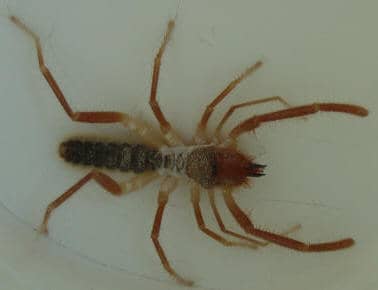
Q. What type of spider has only 6 legs? Are they poisonous?
A. No spiders have 6 legs unless someone pulled 2 of them off!! Insects have 6 legs and 3 body parts, spiders have 8 legs and 2 body parts!! Spiders are venomous not poisonous.
Q. Is it true that the noise you hear in the night is many spiders?
A. I haven’t heard this one before but my answer would be no, it’s not. Spiders don’t make a noise and there certainly wouldn’t be that many around to make one.
Q. Were there spiders back in the ice age?
A. Yes, there has been evidence of spider web trapped in amber from the cretaceous period so they would have been around during the ice age as well. Click here for the full story. There are also many examples of spiders found in amber from the Chiapas highlands near the town of Simojovelamber. Chiapas amber is between 22 million and 26 million years old and comes from the resin of the Hymenaea Leguminoseae tree. Click here for photos.
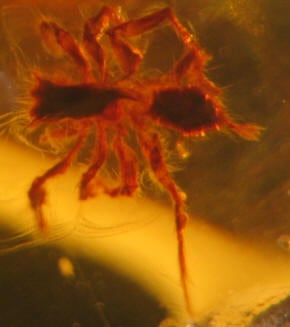
Q. Can a spider’s web be stronger than steel?
A. Yes, for an equivalent weight, the strongest spider silk has a tensile strength that is five times greater than steel. Tensile strength is the amount of longitudinal stress that a substance can tolerate without being torn apart (a measure of how hard can you pull on a string before it breaks).
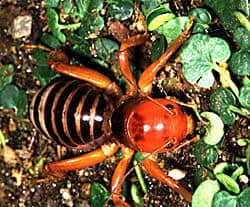
Q. What is the most potent spider – the Brazilian Wandering Spider or the Sydney Funnelweb?
A. All my research shows that the Brazilian Wandering spider is considered the most venomous spider in the world. However as far as being most potent, the Sydney Funnel Web can kill in 15 minutes so maybe it is more potent.
Q. What is the largest spider in Ireland?
A. The raft spider (Dolomedes fimbratus) is , without a doubt, Ireland’s most impressive spider. Primarily a spider of bogs and fens, it is always found close to water, is semi-aquatic and has an intriguing hunting technique that’s unique among Irish spiders. With a body length of up to 2.2cm (just under 1 inch) and a leg span approaching 7cm (c. 2.75 inches) this is Ireland’s largest spider by some margin. It is a chunky, heavy-set spider, mostly brown in colour with a distinctive pale stripe running from the head down each side of its fat, cigar-shaped body. It is one of the fishing spiders.
Q. Do tarantulas react aggressively toward loud noises?
A. I think that would be grossly over acted on Home Alone!! Tarantulas will react toward anything they see as aggressive and will rub their legs together and throw their urticating hairs in the direction of the threat but I don not believe they would chase after people. Tarantulas in fact often inflict a dry bite when in danger to deter the aggressor, having no intention of eating them!!
Q. How often should I feed my new tarantula?
A. I am not an expert on tarantulas, we don’t even have them here in Australia. However, I think that tarantulas are like most spiders – they eat when there is food available and then can go without for a long time if there is none. I would only feed her a set amount, not keep feeding her because she looks like she is hungry. Once she gets used to her new environment she will know when to expect food. There is also the danger of overfeeding and if there are lots of food debris lying around that can go mouldy and spoil her environment. Here’s a good article on www.tarantulas.com – they also have other advice on their site:
“How often you feed your tarantula is up to you. Some people want their spider to grow as fast as possible and will offer food almost every day. However, offering food every 4-7 days for young spiders and every 10-14 for larger specimens is a reasonable regimen. Do not feed freshly molted tarantulas for several days [young] to two weeks [adults]. Spiders, in general, will keep eating until they are full, approaching a molt, or ready to lay an egg sac. In a sense, you can’t really overfeed young tarantulas, but this isn’t the case with adults. An adult tarantula might only eat once a month or even as little as a few times a year in the wild.
A tarantula’s abdomen should not be overly large and impede its ability to move about with ease. It is extremely important to remove any uneaten prey items whether live or dead within 24 hours or so. I recommend offering food late at night and removing it first thing in the morning if not accepted. Uneaten insects or other prey items can be stressful for the tarantula, and have been known to damage and even kill tarantulas if not eaten. Food remains like the bolus will attract pests and mold. It is advisable to remove the remains of any prey items from your tarantula’s enclosure so that they do not cause unhealthy conditions for your pet.”
Q. Does a spider always builds its web facing to the south?
A. I think it is false. I found reference to spiders building their webs different ways depending on their habitat – shaded areas the webs faced east/west with the spiders facing north/south and open areas the spiders faced east/west and the webs north/south but that was just one species. It also seems to depend on exposure to sun and wind as well, so I would say don’t depend on a spider webs orientationt if you are lost!!
Q. Is there a “scientific” or specific name for spider droppings?
A. Apparently, spider droppings are primarily made of guanine, and thus spider droppings are commonly discussed as such. It is a white colored reflective pigment for many spiders and as it is non-soluble, they can excrete it with little loss of body moisture. I find it interesting that the guanine nucleoside is called guanosine And now we are both enlightened as to the proper name for spider poo: Guanine
Q. Have a spider bite, what should I do?
A. Sorry but I am not a doctor so I can’t give you medical advice. Please see your doctor if it is of concern to you and they will prescribe the correct treatment for it. It would also help them to know what spider bit you.
Q. Do spiders have blood?
A. Yes but it’s not red like ours. The blood of spiders contains many pale blood cells and is slightly bluish in colour. The heart, is a long, slender tube in the abdomen, and pumps the blood to all parts of the body. The blood returns to the heart through open passages instead of closed tubes, such as those of the human body. If the spider’s skin is broken, the blood quickly drains from its body.
Q. Are there really Tarantulas in Maryland?
A. I would imagine it would be too cold in Maryland as tarantulas live in tropical and desert areas. The tarantula society says: “There are over 50 species of tarantulas native to the south western and central portions of the United States, including several undescribed species (unknown to science). They can be found in all or parts of (going in a circle): California, Arizona, New Mexico, Texas, Louisiana, Arkansas, Missouri, Kansas, Oklahoma, Colorado, Utah, and Nevada. Their eastern border is the Mississippi River and further to the north, the Missouri River. There is an introduced population of Brachypelma vagans in central Florida, but this species is indigenous to southern Mexico and Belize.”
Q. If a spider was to be in your bed or clothing or something like that, would they bite you?
A. Often spiders get in beds and are rolled on by people and if they can bite them to let them know they are there, they will, it is a defense mechanism. However there is no evidence that spiders descend at night time and snack on people because they look tasty, we are not natural prey for spiders and they will avoid us and all larger animals if they can.
Q. Can spiders walk on each others webs?
A. There seems to be no definitive answer to this one. Some sources say no and others say yes. Some spiders even get stuck in their own web so I guess it is possible that other spiders can get caught. Here’s some info from Everyday Mysteries:
“Many people believe that spiders have special oils that repel the stickiness of their threads. This, however, has never been proven. Scientists are still not entirely certain how most spiders manage to avoid ending up ensnared in their own trap, but there are a few accepted theories. Spiders can spin different kinds of silk, and not all of their silk is sticky. In fact, in a spider web only the silk used for the intricate catching spirals are dotted with glue, so spiders know which threads to avoid. In addition to producing different kinds of silk, web-spinning spiders also have an extra set of claws on their feet. All spiders have two claws on their feet; web-spinning ones have three. These claws are used to grasp threads and provide traction as the spider moves along.”
Q. Is there a spider who doesn’t make a web?
A. All spiders can spin silk but there is a group of spiders called hunting spiders that don’t spin webs to catch their prey but either lie in wait for them in flowers etc like the flowe spiders or hunt along the ground like wolf spiders or in houses like the huntsman spiders.
Q. I have lumps and blisters from handling my tarantula, what should I do?
A. Firstly try not to handle it!! Some tarantulas have hairs on their legs and body called urticating hairs. These are a defence mechanism and they come off into hands and predators mouths when they are handled. Some people may experience no reaction, others a mild reaction and others a severe allergic reaction. Small bumps and redness are typical symptoms. If they get into the nose and the other airways then a burning/stinging sensation is common along with constant uncontrollable sneezing and even wheezing or restricted breathing. If they get into the eyes then the eyes will water uncontrollably and the hairs may even cause temporary blindness. If you are worried, see your doctor. Antihistamine tablets and cream will help with the itching.
Q. Do spiders ever live on other animals?
A. I could find no information that suggested that they could or would want to live on other animals. Finding a spider on an animal would only be a coincidence.
Q. Some one once told me that if you kill a lot of spiders in your life time, that spiders can sense it and that they are more likely to crawl around you more. Is that true?
A. Sometimes I’d like to think it was as I’m really against people killing every spider they see!! But there is no way it could be true.
Q. Why does Omaha Nebraska have so many spiders. do you know the answer to that one?
A. I really can’t say. Maybe the weather and other conditions like the amount of insects or lack of natural predators means that they have more likelihood of all spiderlings surviving and creating a larger spider population.
Q. How long to you have to live after a red-back spider bites you?
A. As long as you would have if it hadn’t bitten you most likely!! Most adults are unlikely to die from a red back or black widow bite as it is not usually fatal to an adult. Some people can have a bad allergic reaction and then it can be serious but that can happen with any bite. There is an antivenene for red back and widow bites and it would be safe to see your doctor if bitten but there is no need to panic if bitten by one. They can have a bad effect on children but once again there is plenty of time to get to a doctor and no need to panic!! Many doctors refuse to give the antivene to adults!!
Q. How big is the biggest spider in the world?
A. The biggest spider in the world is the Goliath Spider, Theraphosa leblondi. It lives in coastal rainforests in northern South America. Its body can grow to 9 cm in length (3.5 inches) and its leg span can be up to 28 cm (11 inches). (from: Carwardine, M. 1995. The Guinness Book of Animal Records. Guinness Publishing.)
Q. How long is the gestation period for Grass Spider eggs — once the egg sac appears?
A. As grass spiders only live for 12 months, the female would lay the egg sac at the end of her life span and the spiderlings would probably hatch out come Spring. There is not a lot of info on them in this respect so any other input would be welcome.
Q. I threw a piece of a cookie into a cellar spider’s web and it began eating it. Is human food unhealthy and dangerous for such a spider?
A. Obviously it was a good cookie!! I guess there’s no reason why it couldn’t eat it, they just liquify the food anyway and if it likes it I guess there’s nothing wrong with it! I can’t see that it would be dangerous, maybe unhealthy if it had an all cookie diet!!
Q. Can a bite from a Steatoda triangulosa or a black widow be harmful or fatal to cats?
A. Eating a spider won’t harm a cat as spiders are venomous not poisonous and only the venom being injected through a bite can harm them. Cats and dogs have pretty thick fur covering their skin and generally spiders bites don’t have a great deal of effect on them as they can’t reach the skin easily. It’s only when they get bitten on the nose or somewhere with little hair that the fangs can even get into the skin. However a black widow bite that goes into the skin can be fatal to cats if bitten. Black widows are very shy and bites are rare. Steadota are a relation of the widow spiders but not as dangerous but I would imagine they could still give a nasty bite. Best to keep your house clear of them with the cats around.
Q. Can spider webs be harmful if someone eats them
A. I doubt it. People used to use spider webs to put on wounds in the olden days as they were supposed to have antibiotic properties and stopped bleeding. Scientists are now looking at them to help stop rejection in transplant. So I don’t think that eating silk would harm anyone. [top]
Q. I saw at least a 100 small black spiders going down a grassy hill. Why are there so many?
A. They were probably baby spiders that had just hatched from an egg sac. They will not all live as many will be eaten by predators and others will balloon away to another area. Don’t worry about them.
Q. Have you heard of thousands & thousands of tarantulas migrating across Superstition Highway (US10) towards the end of April?
A. Once again I could not find any information on this online and I’m pretty sure this sort of phenoma would be newsworthy. Tarantulas don’t usually congregate in large numbers or migrate like this. If anyone has more info, please email me.
Viewers Comment: In June of about 1972, I was travelling to Dallas, TX from Lordsburg, NM with several other people. Late in the evening, we broke down about 10 miles West of Big Spring, TX. We spent the night on the side of the road. Early the next morning, we saw a very large amount of tarantulas crossing I-20. It seemed to us that they were migrating. I don’t know where they were going, but they were definitely travelling. And they were big! Carole
Q. Have you ever seen or heard of an albino red-back? Have you ever heard of albinism in this species?
A. The only spider I know of that is white is the crab/flower spider. I have searched to see if there are albino spiders and haven’t been able to find any information on albino redbacks or albinism in spiders in general. So I’d say it is pretty uncommon at least. Just found a news article on an a partially albino trapdoor spider, link below. http://news.nationalgeographic.com/news/2011/11/111108-new-spider-albino-australia-trapdoor-burrows-animals/ If anyone has more info, please email me.
Q. What do spiders do in Winter? What happens to their bodies and what do they eat if anything?
A. Most outdoor web spinning spiders (garden orb weaver family) will die out over Winter and I guess their bodies just fall to the ground and are eaten by ants or birds. Other spiders that do live through Winter just slow down and eat whatever they can catch but spiders can
Q. Are spiders able to “navigate” their way back to where they were living, if removed from their home? If so, how far a distance is “too far a distance” to be able to do this?
A. Spiders are quite happy to be relocated and don’t have any attachments to a particular place or spot. They do lay a line of silk to be able to find their way back to their web though so you need to make sure you put them in a container so they can’t lay down that line and find their way back if only taking them a short way. However, if you try to put a house spider outside it will try to find its way back inside as they don’t like living outside.
Q. There are two daddy long legs in my room and they have been there for almost a month. It is winter and my question is, what should I do with them?
A. Daddy long legs are inside spiders and would die outside. Move them to a basement or attic or garage where they won’t bother anyone.
Q. What spiders don’t bite?
A. All spiders will bite if they are in danger however many of the smaller spiders like some male redbacks and of course spiderlings, are too small for their fangs to pierce human skin. Take care with all spiders and avoid handling them as they may think they are in danger.
Q. Are spiders cold blooded?
A. A spider falls under the classification of arachnid and are there for cold blooded. The spider uses the thermoregulation system of Poikilothermy, as its body temperature rises and falls with their environment. The term cold blooded refers to the way in which the bodily temperature changes with the environment. There are three main areas of thermoregulation under the umbrella term cold bloodedness.
Ectothermy – this refers to creatures that control their temperatures by external means, such as the sun, flowing air or water.
Poikilothermy – this refers to the creatures who’s body temperature rises and falls with the surrounding environment. These creatures would be cold in cold areas and hot in hot ones, changing as they move between them.
Bradymetabolism – this refers to creatures who have a high active metabolism and a low resting metabolism. These creatures can undergo dramatic changes in their metabolic rate, depending on food availability and temperature. This allows creatures, such as those who live in the desert, able to shut down their body’s and approach a near death sate, to survive harsh desert winters, until favourable conditions return. Only a few creatures fall into all three categories, or use more than one method to control their body temperature. Most creatures rely on one type of thermoregulation to survive, such as snake and lizards lying on rocks, or insect vibrating their muscles in one place to keep warm. It was originally thought that cold blooded creatures were incapable of controlling their bodily temperatures. It is now known that this is not the case and the term is therefore outdated in scientific content today.
Information – Wikipedia.
Q. Just yesterday when I was washing my trash can I found a black with white stripes spider I was wondering if it was dangerous, I didn’t get the chance to kill it cause it was so fast that I was terrified of the spider. Would you please let me know?
A. Well it may not have been dangerous but I can’t possibly tell without a photo. There are more than 35 000 different species of spiders and it is impossible to tell which spider it is or if it is poisonous, from a brief description . Even with a photo it is sometime impossible to tell the difference between many of the spiders that look the same!! I’m also not an arachnologist and only they have the specialised skills to really identify a spider.
Q. I have a question about the banana spider outside my window. I “adopted” this Spider outside my window and had some questions about feeding him. I give him a grasshoper everyday, and he eats them. But I was wondering if I’m feeding him too much, and if he eats too much if he will die? I’m asking this because I used to feed another huge one down the street, and eventually after a couple of days, it disapeared. Sorry to bug you if this is alredy on the spiderz rule web site, I looked and didn’t see it. I really like your (if it is yours) site, and I’ve learned alot from it. Also, I have these two tiny little spiders ( I think are cross spiders) that have a mess of web in the bottom corners of the slider door that we never use, I give them a little ant every day, pretty much what I’m asking is if I give them food every day will they die?
A. If the spider outside your window has access to natural food then what he catches should be enough. However it shouldn’t hurt him or the small ones to be given food every day, I have found that if they aren’t hungry they won’t eat it anyway. The other one down the street was probably at the end of its life span as argiopes only live for around 12 mths then lay their eggs and die. Be careful with large grasshoppers as their legs are very powerful and can hurt the spider.
Q. I was wondering if you have any documentation/picture of spider egg laying on humans, specifically under skin. I heard of this but my wife will not believe me.
A. In a surprisingly widespread urban legend, a nameless woman is bitten by a spider (usually on her cheek) while on vacation. She later develops a swelling, from which, in due course, baby spiders emerge! Somehow or other, the venom must have transformed into eggs. Spiders, need I say, do not find the human body a suitable site for egglaying, and no actual case anything like this can be found anywhere in scientific or medical literature. That is, unless you count as scientific literature the book Dancing Naked in the Mind Field by Nobel Prize chemist Kary Mullis. In one chapter, Mullis claims to have been bitten by a brown recluse spider in California (where no such spiders exist), that other spiders came back to feed on the resulting wound, and that female brown recluses feed their babies from such wounds.
Q. Is it absolutely impossible to find a brown recluse spider in California?
A. No, one could be carried from other parts to California. But, because of the misinformation surrounding the brown recluse‘s presence in California, many spiders that are virtually harmless are submitted by the public for identification. Most of them are not from the recluse family and some are not even spiders. A nationwide study was undertaken from 2000 to 2005, offering to identify any spider that was considered to be a brown recluse spider. Nearly 600 specimens were submitted from California, many from people who were adamant that they had a brown recluse. Only one of these specimens was a brown recluse, from a house where the family had moved from Missouri. No additional recluses were found in the house. The occasional finding of a translocated spider is not overly surprising, however, it still does not happen often. There were 17 desert recluses in this study, all submitted from the desert regions of south eastern California where the spiders are known to occur. Yet non recluse spiders were submitted in great numbers including many false black widow, woodlouse, and yellow sac spiders. Presented below are descriptions of spiders that share some of the same physical features as the brown recluse and have been misidentified as recluse spiders. (This article is from UC IPM Online Statewide Integrated Pest Management Program. Click here for the full article)
Q. How should I act to prevent being bitten by spiders when gardening? I never wear gloves.
A. You need to wear gloves to prevent being bitten, it’s a good policy in any case as other problems can occur from gardening as well, especially using potting mix etc and of course there is the chance of being bitten by any of the bugs, insects and spiders that make the garden their home.
Any spider can cause illness or bad bites if the person has a bad reaction to them or an allergy but the same happens with insect and bee stings etc. If you are bitten by a woodlouse hunter spider, treat it as you would a bee sting and keep an eye on it. If it gets worse or you have any symptoms like shortness of breath or swelling then go to the hospital or your doctor and try and take the spider with you.
Q. Why do we have spiders?
A. If we didn’t have spiders and other creatures like them we would be overrun with insects that are the spider’s prey. Every animal has a part to play in the food chain and spiders are an important part of that. Likewise birds and other animals feed on spiders so they provide food themselves for animals higher up the food chain. Only a very few spiders are dangerous to humans, most spiders bites are no worse than a bee sting.
Q. Have you heard of the Assassin spider newly discovered in Madagascar?
A. In 1854, the first assassin spiders were discovered as fossils in amber from northern Europe. It wasn’t until 27 years later, in 1881, that living assassin spiders were discovered in Madagascar, Australia and South Africa. Scientists from the California Academy of Sciences in San Francisco and researchers in Madagascar recently found nine new species of assassin spiders whereas previously around a dozen species had been reported. Assassin spiders possess very long necks so they can attack their prey from a distance and grow to less than an eighth of an inch long. They stab helpless spiders with their sharp, venom-filled fangs attached to their super-sized jaws. They don’t build webs but go hunting for their prey.
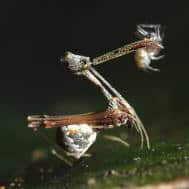
Q. Do spiders make a noise?
A. Yes, some spiders can make a noise. Goliath bird-eaters, as well as some other tarantula species, have the ability to make noise. We don’t normally associate spiders with noise, like we do with dogs, cats, birds, etc. We are accustomed to seeing spiders silently, stealthily crawling across walls, floors, and the sidewalk. But when feeling threatened, the goliath bird-eater is capable of making a pretty loud hissing noise by rubbing bristles on its legs together. Called stridulation, it can be loud enough to be heard up to 15 feet away.
Q. Can spiders kill pets?
A. Yes, spiders can kill pets, especially ones like the brown recluse. Others however like the Sydney Funnel web spider, one of the most dangerous, can only harm humans and monkeys so it really depends on the spider and what sort of venom it has. To be safe keep pets away from spiders where possible and keep adventurous kittens especially, inside.
Q. What would happen if two spiders of the same species or two snakes of the same species were injected with their own venom?
A. The venom is contained in the poison gland and doesn’t get into their blood stream. Once it is injected into them through a bite, it would have the same effect as being bitten by another spider or snake.
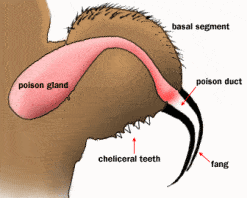
Diagram – Howstuffworks.com
Q. How long do jumping spiders live for?
A. I couldn’t find an exact time length – it seems to range from about 3 mths to a few years. The only really long lived spiders are the myglamorphs, although wolf spiders and black widows can live for several years.
Q. Do spiders wee and poo?
A. If you look at the anatomy of a spider, you will see it has an anus like other animals to rid its body of waste material. Often you will see pieces of its food caught in its web and this has been eliminated from its body as “poo”. However, spiders have no opening in the body to eliminate fluid waste, so they do not “wee”. Many spiders like tarantulas drink water and will sip water droplets on their webs. If the spider gets enough food and the humidity is right, they don’t need to drink water but will to compensate if their body is dehydrated.
Q. What colour is spider’s blood?
A. Blue colour. Hemocyanin binds oxygen but only releases it after it receives the right chemical signal. For every of the 24 sub-units there is special chemical signal. Depending on the need for oxygen a cell can give many or less signals. Beside these signals the release of oxygen is also controlled by temperature. Every sub-unit has a specific temperature optimum. Spiders have an open blood circulation system. Blood vessels do transport the blood to a specific place but thereafter the blood flows freely in the open spaces between the organs.
Ed Nieuwenhuys, March 1999
Q. Can spiders move their eyes?
A. Most spiders have very poor vision and can see very little. They rely on vibrations and their senses to alert them rather than eyesight. The jumping spider however has eight eyes which are grouped four on the face (the two big eyes in the middle, and two smaller eyes to the side), and four on top of the carapace (two medium-sized eyes toward the back, and two very small eyes in front of them). The 2 large ones on the face have better vision but their field of view is reduced. They move their carapace rather than the eyes which are fixed in the socket, however they can rotate the retina for a better view. The other six eyes act like our peripheral vision, with lower resolution but a broader field of view. All spiders have “simple” eyes which have light-sensing cells. Light travels through the lens and hits the cells, which send a message. Flies for example, have “compound” eyes which don’t provide clear images of the world around them. But they are very good at detecting motion. That’s why it’s so hard to catch a fly!
Q. Do spiders hibernate in Winter?
A. Spiders like the garden orb weavers, argiopes, widow varieties that only live one season, will die in Winter, leaving behind their egg sac for the next season. Other spiders like tarantulas and fishing spiders, that live longer may hibernate in Winter spending the cold weather under tree bark or rocks, or in cellars and attics. Some adults survive by preparing a winter nest of silken webbing under loose bark within which they are insulated from the cold. In several species, young spiderlings hatch out, then remain in a communal webbed egg sac through the winter. Those spiders that hibernate in leaf litter and in rock piles often are not deeply asleep, and on mild winter days may crawl about in search of insect food that is plentiful and easy to secure in its dormant state. Young spiders often take refuge in moss, and should you bring a clump into the house, be prepared to have spiderlings and many other little hibernating creatures crawl out as warmth unlocks their muscles and increases their metabolism and consumption of oxygen.
Q. What is the smallest spider in the world?
A. I found 2 conflicting reports to answer this question:
The smallest spider in the world is the Samoan moss spider, Patu marplesi, which has a leg span of only 0.017 inches. The smallest known spider in the world also comes from South America, a fully adult male Patu digua from Columbia measures about 0.37 mm (0.015 in). The smallest known female spider is Anapistula caecula from the Ivory Coast in West Africa, it measures 0.46 mm (0.018ins). It is worth mentioning because males are usually smaller than females in most spider species, but the male of this species has not been found yet, thus it may be the smallest known species when it is finally known.
Q. Why don’t spiders get caught in their own webs?
A. Spiders have two special tricks that keep them from sticking. The first trick is knowing where to walk. Many spiders make sticky strands of silk that trap insects. But they make other strands that aren’t sticky. As they crawl around on their webs, they just avoid the sticky strands. The other trick is pretty “slick.” Spiders rub their feet over special glands around their mouths. These glands make an oily goo that oozes out onto the spiders’ feet. The slippery stuff helps them get unstuck if they make a mistake and step on a sticky strand.
Q. Do spiders have a sixth sense or spider sense which they sense danger or someone is approaching?
A. No, I don’t think so, not really, probably they feel vibrations in their webs or on the ground that alerts them to something approaching. The belief that wild and domestic animals and spiders, possess a sixth sense—and know in advance when the earth is going to shake—has been around for centuries. Wildlife experts believe animals’ more acute hearing and other senses might enable them to hear or feel the Earth’s vibration, tipping them off to approaching disaster long before humans realize what’s going on. Before giant waves slammed into Sri Lanka and India coastlines not long agao, wild and domestic animals seemed to know what was about to happen and fled to safety. According to eyewitness accounts, the following events happened:
• Elephants screamed and ran for higher ground.
• Dogs refused to go outdoors.
• Flamingos abandoned their low-lying breeding areas.
• Zoo animals rushed into their shelters and could not be enticed to come back out.Peter Parker’s spider sense is a figment of the imaginations of those who made him up but probably had its basis in this phenomena!!
Q. Do spiders eat their own webs?
A. Yes, some spiders do eat their own webs. Some types of orb weavers, like the garden orb weaver, who remake their web nearly every day, do eat their own web. Because the spider silk in the web is made of protein and takes a lot of energy to make, these spiders usually eat their old webs before making a new one. Do you think it tastes better than insects?
Q. Is there a special term for a baby spider?
A. Yes, they are called spiderlings.
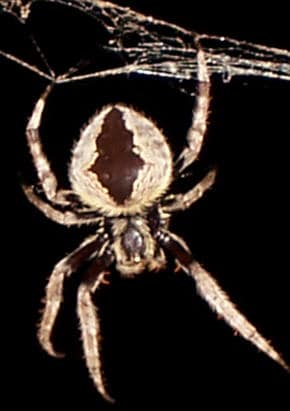
Q. Supposedly the outside of the spider’s eye can’t move, but the inside can. Can u tell me if it does, and if it does how does it do it?
A. Spiders look around them partly by moving the carapace, but the eyes can move as well. This is not done by moving the whole ‘eyeball’, since the lenses of the eyes are actually built into the carapace. Instead the retina moves around, while the lens stays fixed. This retinal movement is accomplished by small muscles.
Q. Many of the venomous animals, snakes and spiders seem to have indications ie redback to warn predators or other animals. eg rattlesnake, Why?
A. I suppose Mother Nature designed animals so that they could warn other animals off first as it’s easier than fighting for their lives when something does actually attack them. Animals only attack other animals to eat them for food, not out of any emotion so it is easy for them to distinguish what is food and what’s not if they have that inbuilt instinct to recognise danger in the form of sound or colour. They use colour in other instances too like mating.
Q. Is there is a common characteristic that poisonous spiders share that makes it relatively easy to identify?
A. No, Unfortunately there isn’t a common characteristic but the fact that there’s a couple of spiders in most countries that are dangerous makes it pretty easy to remember what they look like and I find that this applies to most countries, USA has only around 4, Aus has only 2 or 3 so once you learn them it’s easy. Some people say that a red colouring marks them as dangerous but this isn’t true as there are several pretty red spiders that aren’t considered dangerous. People can also be allergic to spider bites like they are with bees etc so it’s best to not handle them unless you are an expert or own a tarantula like you do. BTW – Spiders are venomous, not poisonous which means that if you ate one they would not poison you but could inject venom into you, which is how ALL spiders kill their prey. However, in the majority of cases a spider’s bite is no worse than a bee or wasp sting.
Q. Do black Widows really make their homes in toilet seats?
A. They make their homes under the rims of things so it is quite possible that they would at one time make their webs under the rim of a toilet seat.
Q. I have this bump n my mouth and it isnt just a little bump it is a big bump. I was told it may be spider eggs in my mouth. Is this true?
A. No spiders don’t lay eggs in wet damp places like mouths or other body parts!!
Q. Is there such a thing as a stone spider?
A. Yes, it is a nocturnal hunter which spends the day in a silken retreat (sac) under stones or loose bark and lives in Europe, N Africa and much of Asia to Japan.
Q. Can a spider catch something bigger than them??
A. Yes, spiders have been know to eat birds and snakes which are much bigger than they are.
Q. Are spiders classified as warm blooded or cold blooded animals?
A. They are cold blooded. With a few exceptions, all mammals and birds are warm-blooded, and all reptiles, insects, arachnids, amphibians and fish are cold-blooded.
Q. I have been told that when spiders are born they are blown up to space and then come back down to earth.
A. No they don’t go into space but they can go fairly high. When the young spiders are ready to leave the web, they start “ballooning”. To do this they release silk lines that the wind lifts along with the spiderlings and blows them to a new area. It is like a kite or parachute being blown by the breeze. The spiderlings are carried off in all directions and float to the ground when the breeze stops or the silk breaks. This ensures that there are not too many spiders in one spot but many are eaten by birds or other predators, and this keeps the spider population to a reasonable level.
Q. Is this spider poisonous?
A. No, spiders are NOT poisonous, they are venomous. Technically all venoms are a poison however not all poisons are venoms. Many times people get confused because someone says that a spider is poisonous while another says it is venomous. Any type of animal like a spider or snake that injects a toxin into your body is venomous. If you touch or eat a toxin from a plant or animal and become sick, then it is poisonous. Spiders that inject toxins from fangs, snakes and some lizards, are venomous while plants, amphibians, and fungi (mushrooms) are all poisonous. So as a rule – poison is ingested (eaten), venom is injected. Poisonous toxins – chemicals that are harmful to the body – must enter the body through the mouth, venomous toxins enter through the skin.
Q. How deadly is the bird eating spider?
A. The bird eating spider in Australia is a type of trapdoor spider. There is also a Goliath bird eating spider in the US, which is the world’s largest spider. The Australian ones are not deadly but their bite can be dangerous as they have large fangs. The Goliath bird eating spider should also not be handled either as they are aggressive and have urticating hairs as well. Its bite can also cause damage from the size of the fangs. http://animal-world.com/encyclo/reptiles/spiders/GoliathBirdEatingSpider.php
Q. Are spiders cold blooded or warm blooded?
A. Cold-blooded animals do not have a steady inside body temperature. These animals have an inside body temperature that matches the temperature outside. Spiders are cold blooded and don’t like the cold weather. Many spiders’ life cycle sees them live through Summer and Spring and then die off in the cooler months. Those that live longer will slow down in winter and even appear to be hibernating.
Q. Do spiders make a noise?
A. Yes, some spiders can make a noise. Goliath bird-eaters, as well as some other tarantula species, have the ability to make noise. We don’t normally associate spiders with noise, like we do with dogs, cats, birds, etc. We are accustomed to seeing spiders silently, stealthily crawling across walls, floors, and the sidewalk. But when feeling threatened, the goliath bird-eater is capable of making a pretty loud hissing noise by rubbing bristles on its legs together. Called stridulation, it can be loud enough to be heard up to 15 feet away.
Q. Can spiders kill pets?
A. Yes, spiders can kill pets, especially ones like the brown recluse. Others however like the Sydney Funnel web spider, one of the most dangerous, can only harm humans and monkeys so it really depends on the spider and what sort of venom it has. To be safe keep pets away from spiders where possible and keep adventurous kittens especially, inside.
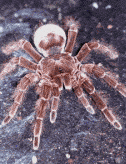
Q. Do spiders crawl in my mouth and nose while I am sleeping?
A. I think it would be highly unlikely that spiders would crawl into a person’s mouth or nose while they sleeping. For one thing we move around a lot while we are sleeping and this would deter a spider from even crawling on you, let alone enter any orifice, especially one which is wet and dark. Breathing through your mouth or nose would also deter a spider from entering and most house spiders are too big to fit into a nose in any case. Spiders, like virtually all arthropods, flee from breath. After all, there are lots of vertebrates that eat arthropods, and if you’re an arthropod and something is breathing on you, it’s not a good idea to stick around.
For a spider to get into your mouth while you’re sleeping, (a) you must have your mouth open when you sleep, which is certainly not something that everyone odes, so there’s a big chunk of people who can never swallow anything; (b) there has to be a wandering spider in your immediate vicinity, also something which–for most people in the civilized world, at least–is a fairly rare occurrence; (c) the spider has to either jump or fall into your mouth from a long distance, because they won’t go near your mouth otherwise (they’re not suicidal), and the odds are pretty astronomical of a spider randomly dropping into your mouth from the ceiling.
There is a story about humans eating eight spiders a year in our sleep without knowing it and that it was supposedly tested by filming people in their sleep for a year. It is hard to believe that a group of people in different sleeping situations would have been filmed for a year or more to validate this statement. It is possible for a spider to walk into your mouth and trigger the swallowing mechanism at the back of the throat and this could in fact occur on a rare occasion. It may even be true that there are a few people out there who have unknowingly eaten eight spiders in the last twelve months. This still would not make such a generalisation be considered as true. I certainly wouldn’t lose any sleep worrying about spiders while you sleep!!
Q. If so, what can happen to a person once they hatch?
A. No, spiders lay their eggs in egg sacs which are attached to an immovable object. Unless you were comatose in a dark corner for a long time, it is hardly likely. When spider eggs hatch they are so small that they pose no threat to humans in any case.
Q. I am terrified of spiders, what do I do?
A. Many people are afraid of spiders in fact it is one of the most common fears. However, there are probably dozens or hundreds of spiders in your house that you never see and will never hurt you. Spiders are everywhere, even on the top of Mt Everest and you won’t escape them. Fortunately, just about all are harmless creatures and even the dangerous ones are more afraid of you than you are of them. Can you imagine a creature thousands of times your size seeing you, then running away screaming in terror? This sounds a bit silly doesn’t it? Most people don’t have the sort of weapons necessary to kill such a beast, and likewise, very few spiders have the venom to kill a person. Less than 1/20th of 1% of ALL spider species have venom that could cause even a little illness in humans. If your fear of spiders has gotten to the point where it interferes with your everyday life, you should see a psychiatrist who can help deal with phobias. Many people have reported that looking through our photos pages has helped them overcome their fear, when they see what beautiful creatures they really are and come to appreciate them and the fact that they won’t hurt them.
Q. How do I get rid of spiders without using pesticides?
A. 1. Eliminate or shield outdoor lights or bright indoor lights that attract flying insects.
2. Trim weeds around the building foundation and remove debris to discourage insects and spiders from living next to a structure.
3. Seal openings and install screens and door sweeps to prevent spiders from moving indoors.
4. Use a vacuum to remove webs, spiders and egg sacs.
Q. Do all female spiders eat the male after mating?
A. A new study has been done on why female spiders eat the male. Here is the article:
Female spiders who eat would-be suitors produce more babies, and those babies are stronger and bigger, than spiders who stick to more mundane fare, researchers reported on Tuesday. And the merciless mother spiders waited until they had mated with another — ensuring they would hatch spiderlings — before consuming their new beaux, the researchers found. They said their study is the first “natural” experiment to prove correct the old folklore about spiders, and said it also shows why such behavior might be beneficial.”Now we know that, at least in one species, sexual cannibalism benefiting females occurs in nature,” Dr. Jordi Moya-Larano of the Estacion Experimental de Zonas Aridas in Spain, who led the study, said in a statement. The Mediterranean tarantulas in the study did not eat their mates, but instead ate males before courtship — and usually after the females had already mated with another male, the researchers found. Some other studies have suggested that males may sacrifice themselves for the sake of their offspring, but this study showed that, at least in this species of spider, the males are purely unlucky victims and only the babies benefit. Some studies had also suggested that studying spiders in the lab produced skewed results, perhaps because the creatures were stressed or perhaps because they could not obtain all their needed prey or nutrients. So the researchers set up a field experiment in which they watched the spiders, sometimes snatching the males from the jaws of females before they were devoured.”At natural rates of encounter with males, approximately a third of L. tarantula females cannibalized the male,” they wrote in their report, published in the Public Library of Science journal PLoS ONE.”The rate of sexual cannibalism increased with male availability, and females were more likely to kill and consume an approaching male if they had previously mated with another male,” they added.”We show that females benefit from feeding on a male by breeding earlier, producing 30 percent more offspring per egg sac, and producing progeny of higher body condition. Offspring of sexually cannibalistic females dispersed earlier and were larger later in the season than spiderlings of non-cannibalistic females.”One theory had also held that females who ate males were simply more aggressive and perhaps better hunters — but when the males were saved just in time, those females did not produce superior broods, suggesting that the male meals were an important source of nutrition.
The study can be found at: http://dx.plos.org/10.1371/journal.pone.0003484
(Reporting by Maggie Fox; Editing by Julie Steenhuysen and Sandra Maler)
.
Q. Are Daddy Longlegs the most poisonous spiders in the world?
A. Spiders are venomous not poisonous. Daddy Longlegs (Pholcus phalangioides) have fangs which are generally too small to harm humans, the most they will produce is an itchy red lump. They are however quite dangerous to other spiders and have been known to kill Redbacks, which is perhaps where they got their reputation.
Q. I found this spider inside, should I take it outside and let it go?
A. No, definitely not. House spiders live inside and don’t want to be “let go” outside, they’d be very unhappy there and maybe even die. They clean up your house by eating all the nasty little insects around your house, so please leave them alone
Q. I received an email about a spider under a toilet seat that had killed many people. Is it true?A. No, this is the Blush Spider hoax that circulated in September of 1999. In Australia, when we used to have outside toilets, Redback spiders were often know to make homes under them and one of our famous poems is “The Redback on the Toilet Seat” by Slim Newton. Perhaps this is where the prankster got his hoax from??
Q. I live in the US and have noticed that we have a ton of very little blood red spiders (outside). When you smash them it looks like blood on your hand. Can you tell me what type of spiders these are?
A. They could be the Red spider, a very small web-spinning mite (Tetranychus telarius) which infests, and often destroys, plants of various kinds, especially those cultivated in houses and conservatories. It feeds mostly on the under side of the leaves, and causes them to turn yellow and die. The adult insects are usually pale red. They are also called the red mite.
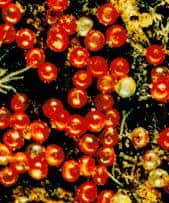
Q. What is that black and yellow spider in my garden?
A. If you are in America it is the Black and Yellow Argiope, Argiope Aurentia, a very common and harmless garden spider. In Australia, they are known as St Andrew Cross spiders, Argiope mangal, because of the white markings in their web which resemble St Andrew’s cross. Other types of Argiope include the Banded Argiope and the beautiful Silver Argiope. Unfortunately this lovely spider only has a short life span and once she has produced one or more (usually no more than 3) brown, papery egg sacs, she will die.
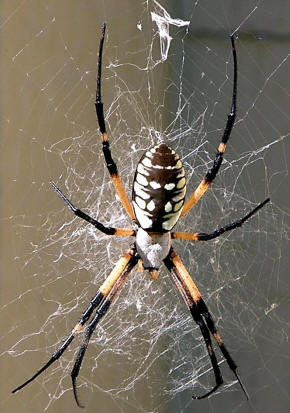
Q. I found these small red bites all over me when I woke up, has a spider been biting me in my sleep?
A. Probably not. Most small red bites are from mosquitoes, fleas, mites, bed bugs or even ants. If you rolled on a spider that was walking across your bed at night it may bite you, but spiders don’t come down and snack on humans at night time contrary to popular belief. Check your ceiling in the morning to see if there are any mosquitoes hanging around up there, wash all bedding in hot water and check for ants wandering around the room before you go blaming the poor old spider!!
Q. What is the largest spider in the world?
A. Theraphosa leblondi. It lives in coastal rainforests in northern South America. Its body can grow to 9 cm in length (3.5 inches) and its leg span can be up to 28 cm (11 inches). (from: Carwardine, M. 1995. The Guinness Book of Animal Records. Guinness Publishing.)
Q. What is the spider that likes to stay in people’s shadows?
A. It is probably the camel spider (solfugid) which is reputed to run after people to stay in their shadows because of the heat of the sand in deserts of Iraq where one type lives. They are the world’s fastest arachnid capbable of speeds when running near 10 mph! Although they have four pairs of legs, they run using only three pairs. They have no venom glands and are not a threat to man although they are very aggressive and fast moving and can inflict a painful bite. The name of the solifugids originates from the Latin for ‘fleeing from the sun’ although many species are nocturnal. The term ‘sun spider’ applies to those species active during the day that tend to avoid the heat and dash from shadow to shadow – often of a person – giving the alarming impression that they are giving chase.
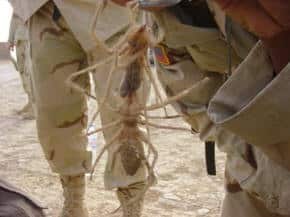
Q. Why don’t spiders fall off walls when they walk up them?
A. Some spiders put a small amount of the sticky silk they use for their webs on their feet and use that to move across walls. Other spiders have specially designed feet and fine hairs that allow them to grasp the irregular surface of walls and ceilings. They cannot climb slick surfaces, because their feet have nothing to grasp.
Q. How long do spiders live for?
A. Different types of spiders live for different amounts of time. As a general rule, the web spinning spiders live for one or two seasons, lay their egg sac and then die off come Winter. The larger hunting spiders and myglamorphs (primitive spiders) like tarantulas can live up to 20 years in captivity.
Q. Is it possible to turn into Spiderman after being bit by a radioactive spider?
A. Unfortunately no, this only a myth created for comic books.
